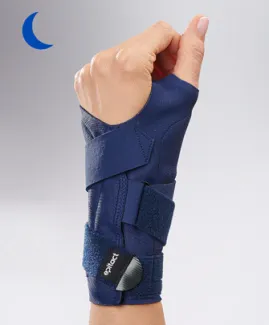
In the United Kingdom, the prevalence of carpal tunnel syndrome (CTS) reaches between 70 and 160 cases per 1,000 persons(1). Tingling, numbness of the thumb, index, middle fingers and half of the ring finger, loss of grip strength... These symptoms can be the result of the compression of the median nerve inside the wrist.
What causes carpal tunnel syndrome ? What are the risk factors ? EPITACT®tells you everything!
How do you get carpal tunnel syndrome?
Most of the time, carpal tunnel syndrome has multiple causes and risk factors. It often appears after 40 years of age, and especially in women.
More generally, every situation that modifies the space which passes the median nerve (located inside the wrist) can favour the development of CTS. The swelling of its components (flexor tendons) or, on the contrary, the narrowing of the carpal tunnel painfully compresses the nerve.
Many factors can be responsible of its onset, either anatomical, physiological or mechanical factors. Now, let's discover what causes carpal tunnel syndrome and all the situations that increase the pressure on the median nerve.
CTS can be a matter of anatomy
The fact that women more often get carpal tunnel syndrome can be explained by anatomical reasons. Indeed, their carpal tunnel is narrower than men’s.
However, men can also develop it. For example, it can be associated with constitutional abnormalities.
A trauma can cause narrowing or deformation of the carpal tunnel. Therefore, the sequelae of a wrist fracture or arthritis reduces the space as necessary for the passage of the nerve and increases its compression.
Metabolic causes of carpal tunnel syndrome
Certain conditions can cause carpal tunnel syndrome because they increase the risk of nerve lesion, including the median nerve. In particular, diabetes: 14% of diabetic people suffer from this syndrome. This figure reaches 30% in the case of neurological complications.
Inflammatory causes of carpal tunnel syndrome
Some inflammatory conditions such as rheumatoid arthritis, as well as other infections, can inflame the synovial sheath of the flexor tendons. This swelling reduces the space available in the carpal tunnel and also compresses the median nerve.
Women, menopause and pregnancy
Why do women get carpal tunnel syndrome more easily? Actually, CTS can be a result of hormonal variations.
Therefore, it is important to frequently observe the development of this syndrome during the last quarter of pregnancy. Fortunately, it disappears after childbirth.
Further hormonal issues can cause carpal tunnel syndrome, such as menopause or ovarian ablation. In these cases, symptoms of carpal tunnel syndrome like numbness and tingling in the hands and wrists take longer to disappear.
Lastly, thyroid disorders (hypothyroidism or hyperthyroidism) and renal failure can be favourable environments for CTS. The increased volume of the synovial tissue excessively compresses the median nerve.
Your job may be the cause of your carpal tunnel syndrome
Carpal tunnel syndrome is admitted as a musculoskeletal disorder and leads to many sick leaves. Indeed, some manual jobs involve repetitive movements (flexion, extension, twisting of the wrist, etc.), which are major causes of carpal tunnel syndrome..
Jobs related to packaging are a perfect example. Unfortunately, the list of occupations at risk is very long:
- Automotive mechanics who screw and tighten with significant efforts of the hand;
- Construction industry workers who are exposed to vibrations from machines;
- Seamstresses who repeat precise movements with angular positions of the wrist;
- Cashiers who bear heavy weights with a repetitive posture;
- People who continuously use a keyboard or a computer mouse;
- Workers who work in a cold environment, etc.
All these people overuse their wrists with inappropriate postures and are then exposed to this medical condition.
Some hobbies are risk factors of carpal tunnel syndrome
If you wonder what causes carpal tunnel syndrome, know that it includes many recreational activities!
Do-it-yourself and gardening include repetitive tasks that mistreat the wrist. The lubrication of flexor tendons can then become insufficient. Frictions between the tendons and the synovial sheath consequently cause inflammation and swelling until compressing the median nerve.
Intensive practice of video games can also lead to musculoskeletal disorders like CTS.
Sportspersons can also get carpal tunnel syndrome
Sportspersons whose practice involves vibrations, or the holding of accessories are also concerned. Golfers, weightlifters, cyclists and racket fans can develop CTS. Inappropriate and prolonged posture during hours can have bad consequences for your wrist.
Using a wheelchair adapted to sport can also be at the origin of CTS.
It is noticeable, from all these examples, that the causes of carpal tunnel syndrome are numerous and often can’t be clearly identified. However, if you succeed in identifying the risk factors of carpal tunnel syndrome in your daily life, you could reduce them and relieve you. To help you ease your symptoms at night, wear the EPITACT® rigid wrist brace*. To limit risky movements during your activities, wear the EPITACT® flexible wrist support*.
You’ve learnt about what causes carpal tunnel syndrome and how some people get it more easily. Now, discover how to treat carpal tunnel syndrome and read about the surgical procedure for carpal tunnel release!

*These solutions are class I medical devices that bear the CE marking under this regulation. Carefully read the instructions before use. Manufacturer: MILLET Innovation. 06/2023
For more details about this general and simplified approach, here is another source:
(1)Mansoor S, Siddiqui M, Mateen F, Saadat S, Khan ZH, Zahid M, et al. Prevalence of Obesity in Carpal Tunnel Syndrome Patients: A Cross-Sectional Survey. Cureus. 9(7):e1519.
 Pharmacie
Pharmacie

